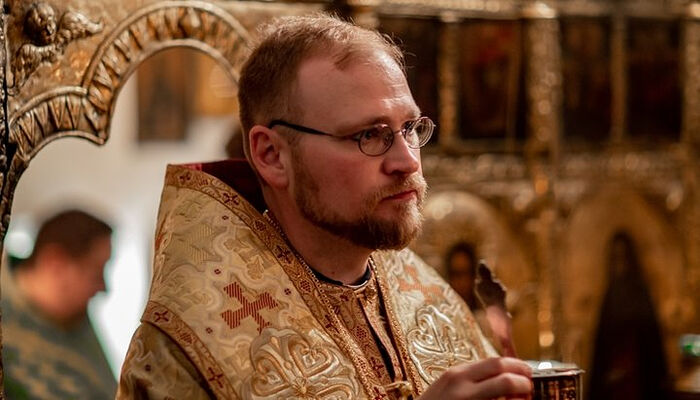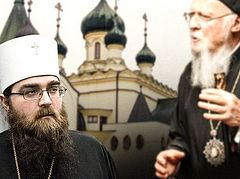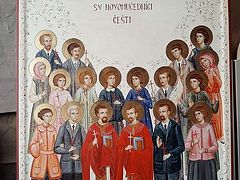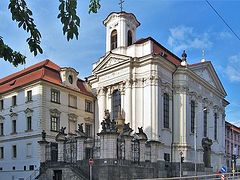—I think that in general, the English-speaking Orthodox audience doesn’t know very much about the Church of the Czech Lands and Slovakia. Could you give us a bit of an introduction to begin with?
—Of course. We are one of the fifteen autocephalous Churches. We are the smallest of the family of the autocephalous Churches, having about 50,000 believers in the Slovak Republic, out of five million inhabitants. That makes one percent of the population. There are two dioceses in the Slovak Republic and two in the Czech Republic where, nominally, there are about 30,000 believers out of ten million, but given the fact that there is quite a high rate of immigration from the former Soviet Union and elsewhere in Eastern Europe, I think the actual numbers could be about 100,000—so again, about one percent of the general population.
It doesn’t look like it, but we are actually the oldest Slavonic-speaking Church. We tend to trace our origin back to the mission of Sts. Cyril and Methodius, but we can go even beyond that, because where what is nowadays the Czech Republic and Slovakia, there used to be the border of the Roman Empire, going along the Danube River. There were definitely traces of missionary activity in the later Roman Empire, in addition to some oral traditions about the preaching of either Apostle Andrew or Paul, or his immediate collaborators—especially in the region of Pannonia, which is modern-day Hungary and some parts of southern Slovakia. There were definitely apostolic Churches, and the border was quite thriving with Christian missionary activity in late antiquity.
The other source of the Christianization of this territory also probably goes to the Church of Milan. At the time of St. Ambrose, there was a small Germanic kingdom on the borders of the modern-day Czech Republic and Slovakia, and its queen, named Fritigil, sent a letter to Bishop Ambrose asking him to send her some missionaries. We’re not sure if this happened, because St. Ambrose reposed in the meantime, and there were other changes, with the arrival of the Slavic tribes, and so on. But it’s definitely one of the sources of Christianization.
Then there were the Frankish kingdoms and empires that were also keen on sending missionaries, also for political reasons, to keep the pagans out of their way, so to say. There used to be a misconception that all of them were purely Latin-speaking, but this doesn’t seem to be the case. Many of them must have been trained in Slavonic, otherwise they wouldn’t have been able to interact with the population. And given the fact that the most active among these so-called Frankish or Germanic missionaries were monks of Irish or Irish-Scottish origin who were very keen on learning local languages and who were really prolific in missionary activity, one can suppose that that really was the case.
Also, in the ninth century, when St. Rastislav, the Prince of Greater Moravia—the Equal-to-the-Apostles as we call him—asked the Byzantine, or Eastern Roman Emperor to send missionaries to his territory of so-called Greater Moravia, in his letter he mentions the fact that “our people have already accepted the faith of Christ but we don’t have good teachers.” This shows that the inhabitants had already been Christianized to some degree. And of course, there are even recorded historical moments of churches being consecrated before the arrival of Sts. Cyril and Methodius, but their missionary activity and wisdom and broadness of heart was something unparalleled until then, given the fact that they were able to put all the already-existing traditions of this territory together and form a united Church organization.
One should not forget that at that period of time, the Archdiocese or the Metropolia of Greater Moravia was part of the Orthodox Patriarchate of Rome. St. Methodius was consecrated as a bishop in Rome with the title of Bishop of Pannonia and Sirmium, which again leads us to the apostolic times, because Sirmium is Srem in modern-day Serbia—one of the thriving centers of the late-Roman empire where the co-workers of St. Paul were definitely active.
The two brothers and their collaborators were wise enough, smart enough, blessed enough, and loving enough to try to employ the language of the local populace as the language of Liturgy. We’re not sure whether the Liturgy was Western or Eastern rite, or a combination of both. There are many possibilities, because there are texts that could point to both options. But the Liturgy was definitely celebrated in Slavonic, in some parts at least. I suppose Greek and Latin were used as well. Slavonic received its sanction from the then-Orthodox Pope himself, Hadrian, who put the liturgical books of Sts. Cyril and Methodius on the altar of St. Maria Maggiore in Rome, thus sanctioning their use.
This is one thing that, for confessional reasons, is often overlooked. You have two Greek brothers being sent from the Eastern Roman Empire but being consecrated by and operating on the ecclesiastical territory of the Church of Rome, still Orthodox, creating an independent Metropolia that was able to harmoniously combine all these differing and often conflicting elements of the Christianity of those days together, despite the existing tensions—especially political.
This is a wonderful thing, but it had a bad end, due to politics. The disciples of St. Methodius were expelled, and then began the great story of what is modern-day North Macedonia, Bulgaria, and Serbia. But it was different here, and it’s a pity it didn’t survive due to different tensions in history. Then Greater Moravia collapsed under the Hungarians who appeared from the east, and this nation was quite quickly Christianized again. There was also a missionary bishop sent from the Eastern Roman Empire; and given the fact that even after the so-called Great Schism, the Hungarian ruling family had many familial and political connections in both Kievan Rus’ and Constantinople, one of the future kings of Hungary was even selected as the heir-apparent to the Byzantine throne—though there was a revolution and he was sent back.
One can imagine that even though they were generally Latin-oriented, up to some point the Hungarians were also quite tolerant, sharing the vision of St. King Stephen the First-Crowned—also a saint in the Orthodox Church—who strongly advised to put all the cultures together and make them cooperate harmoniously. But of course, further on, as things changed, the Latin tendencies prevailed, and Orthodoxy slowly disappeared into thin air. It’s quite a pity because this melting pot of Greater Moravia, which really put the East and the West together nicely—Latin, Greek, and Slavonic—could have been a very interesting, not only religious event but also cultural experiment.
It’s a pity that the inhabitants of both modern countries, who have mainly Latin-oriented traditions nowadays, have lost touch with the Greek and Slavonic-speaking Church and culture and heritage. I also think it’s a pity for the eastern part to have lost the fruitful dialogue with the then Orthodox Latin-speaking world.
As we go through history we reach the Middle Ages, when there was nothing like an existent Orthodox Church organization in the Kingdom of Bohemia, which is the Czech Republic today—even though the Czechs have always been aware of the fact that there was a time when they had their rites in a language they could understand. There are some interesting moments in Czech history, which were later on transformed into Protestantism generally speaking, of attempts to reform and introduce the spoken language into the liturgy, or to take Communion under both kinds. They also look back to the times of Sts. Cyril and Methodius. So a seed had been sewn that didn’t have time to grow, but some roots remained.
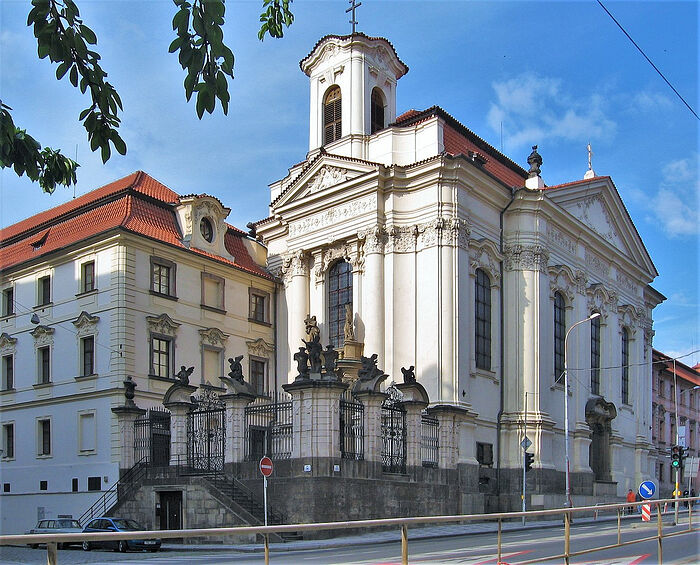 Cathedral of Sts. Cyril and Methodius in Prague
Cathedral of Sts. Cyril and Methodius in Prague
—Vladyka, it’s my understanding that, as you said, Orthodoxy sort of evaporated into thin air in what is now the Czech Republic, but it did hold on better in eastern Slovakia through neighboring Ruthenian Ukraine, and there were also connections with Serbia that were maintained. Is that accurate?
—That’s true, but given the fact that Bohemia was a separate kingdom, and what is nowadays Slovakia was called Upper Hungary, these were often competing kingdoms, and they do have a different history in the second millennium.
Especially in eastern Slovakia, and perhaps up to central Slovakia, the Byzantine rite was quite prominent, with Ruthenian and Slovakian speakers. And those who adhered to the Orthodox Church were part of the ancient Diocese of Mukačevo, which can be traced at least to the fifteenth century. Its bishop always went to the Metropolitan See in Suceava to be consecrated, although he himself had the title of Exarch of the Patriarch of Constantinople. This is quite interesting because this diocese was able to function for both the Slavs and the Romanians. And especially after the introduction of the Unia, the center of the Orthodox Church moved to the Romanian-speaking part of the diocese, which was huge in the past.
It seems the Orthodox influence was further strengthened by the arrival of new colonizers from the mountains, either Romanian or Slavonic-speaking, who were moving towards central Europe and bringing their Orthodox culture with them. Then in the middle of the seventeenth century we have the famous Uzhgorod Unia, which forced the population into a newly created Uniate church for the sake of some privileges, without many of those people even knowing what was happening, and without them losing their understanding of being Orthodox. In my opinion, it was a huge crime, because all of a sudden and with the stroke of the pen, their religious identity was stolen from them without them even knowing about it.
It wasn’t always easy for Uniatism to take hold. For example, there used to be a monastery in Slovakia in Krásny Brod where a Uniate bishop tried to come concelebrate, and he was thrown out by the people gathered there. They didn’t want to hear about the Unia; they wanted to stick to Orthodoxy. So there were turbulent moments, but the Uniate church had the strong support of the landlords and politicians, so they had no other choice but to accept the situation as it was. But even then there were some priests in the Uniate church who went to the so-called “schismatics”—the Orthodox—to be ordained somewhere in modern Romania, to the great displeasure of the Uniate bishop.
—Thank God that at least some people held out.
—Things were slowly dying out though, and the main impetus for a more-or-less return to Orthodoxy was immigration to the United States in the nineteenth century, the second half especially, and the work of priests like St. Alexis Toth—who was actually from Slovakia. This is part of your history I suppose.
—Indeed. I studied at St. Tikhon’s Seminary, and we have his relics there at the monastery.
—Right, so thanks to him, who was writing using the eastern Slovak dialect, and people like him, those who returned back from the States (because there was also a movement going back by the end of the nineteenth century) were either sending their relatives books by St. Alexis or bringing Orthodoxy with them, especially to Ruthenia and Transcarpathia. An analogous movement also appeared spontaneously on the Lemko Polish side of the region, with St. Maxim Sandovich, the future New Martyr (shot in 1914 for his faith) who was doing clandestine work to bring Orthodoxy back to his fellow villagers and countrymen. He was also active in some regions of what is Slovakia today.
And then this movement became more spontaneous, especially on the eve of the First World War, and especially with the famous Maramorosh lawsuits, where simple people from the mountains—shepherds—were tried as traitors and prosecuted by the Austro-Hungarian authorities for returning to Orthodoxy from the Unia and harboring sympathies towards Russia and things like that. This movement of returning to Orthodoxy continued even after the Austro-Hungarian Empire collapsed.
Then Czechoslovakia was formed, having all of Transcarpathia as part of it. It used to be much bigger before it was given to Stalin in 1945. But at the same time, one should not forget that especially in the east, in the kingdom of Hungary, there have been, at least since the fifteenth century, small colonies of Serbian or Bulgarian-speaking merchants, wine merchants especially, creating their communities and building churches and schools. And especially after the great immigration of the Serbs under Patriarch Arsenije in the early seventeenth century, a huge number of people and clergy spontaneously moved to the territory of the Kingdom of Hungary, then under the Habsburgs, to live and settle, having been granted some privileges.
One of their privileges was that nobody would force them to become Uniates—and there were so many people that the Habsburgs really respected their choice. And for a couple of years, the Patriarch himself resided in Komárno Monastery, which is in modern-day Slovakia. There was also a constant Serbian Orthodox presence in the Kingdom of Hungary, but those from Transcarpathia who were seeking help couldn’t apply directly to the Serbian bishop then because it was prohibited by the state. They tried to help clandestinely but it was very difficult when the old Austro-Hungarian Empire was still in existence.
It was completely different when it collapsed, and all those who were seeking Orthodoxy were able to apply to the Serbian bishops for help and to the newly-recreated Patriarchate of Serbia. There used to be an autocephalous Church of its own right on the territory of Austro-Hungary that included Romanians and Serbs. It was autocephalous and accepted by the rest of Orthodoxy, but then part of it became the future Patriarchate of Romania and part of it joined the other separate Serbian-speaking jurisdictions to form the Patriarchate of Serbia. For the government of pre-war Czechoslovakia, it was also quite natural to support the quest for a Serbian bishop and a Serbian-oriented Church as Czechoslovakia was on extremely friendly terms—as is supported by many treaties—with the Kingdom of Yugoslavia.
And the Serbian bishops did a great job, because they came and helped without trying to make the local Orthodox into Serbs. This is a problem in the diaspora sometimes when people don’t want to become Orthodox, but rather want to become Orthodox Greeks or Orthodox Romanians, or Serbs, and so on. So, the pre-war Serbian bishops were wise enough and blessed enough to avoid any such movements.
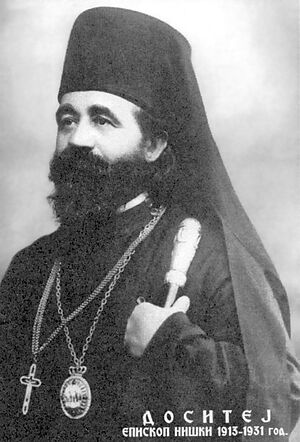 St. Dositej (Vasić) There were many luminaries, including St. Dositej (Vasić), the Metropolitan of Zagreb who was tortured for his activities in former Czechoslovakia at the end of Second World War by the Ustaše in Croatia. There were also Bishop Irinej (Ćirić), Bishop Damaskin (Grdanički), and many other important figures of the twentieth-century Serbian Church, including St. Justin (Popović) of Celije, who was in touch with the brotherhood of St. Job of Pochaev Monastery, which relocated to the east of Slovakia. This is something important to mention. In Ladomirovo, the monks of Pochaev who were fleeing the communists formed a center and created a monastery before later moving to the west of Germany and later to Jordanville, New York. It’s a well-known fact that the late primate of ROCOR Metropolitan Laurus, who signed the act of communion with the late Patriarch Alexiy, was a native of eastern Slovakia, a native Ruthenian. This monastery did a tremendous amount of work, alongside the Serbs and in cooperation with them.
St. Dositej (Vasić) There were many luminaries, including St. Dositej (Vasić), the Metropolitan of Zagreb who was tortured for his activities in former Czechoslovakia at the end of Second World War by the Ustaše in Croatia. There were also Bishop Irinej (Ćirić), Bishop Damaskin (Grdanički), and many other important figures of the twentieth-century Serbian Church, including St. Justin (Popović) of Celije, who was in touch with the brotherhood of St. Job of Pochaev Monastery, which relocated to the east of Slovakia. This is something important to mention. In Ladomirovo, the monks of Pochaev who were fleeing the communists formed a center and created a monastery before later moving to the west of Germany and later to Jordanville, New York. It’s a well-known fact that the late primate of ROCOR Metropolitan Laurus, who signed the act of communion with the late Patriarch Alexiy, was a native of eastern Slovakia, a native Ruthenian. This monastery did a tremendous amount of work, alongside the Serbs and in cooperation with them.
But of course, if there are two Orthodox there are five opinions, so there were some tensions. And so some people also appealed to Constantinople for jurisdiction and a bishop, who was a Czech but never really had much support. Thus, there were three traditions mingling together again, and not always amicably—the Constantinople tradition, which was a minority, the Serbian, and the Church Abroad-Karlovtsy Synod. Later on, there was also the jurisdiction of Metropolitan Evlogy of Paris, which was also under Constantinople but under very vague terms. The bishop under Metropolitan Evlogy and the Czech bishop consecrated by Constantinople couldn’t get along very well, although they were part of the same Local Church.
Also, pre-war Czechoslovakia was one of the biggest and most important centers of Russian immigration. First was Paris, and then Prague, with its language school. Other parts of Czechoslovakia, such as Bratislava were also popular. So you have all these things together, working more or more less harmoniously, with some occasional tensions… and then comes the Second World War, which was a complete disaster. The Czechoslovakian state ceased to exist. The clero-fascist regime proclaimed independence; Bohemia and Moravia were first stripped of some territories that were joined directly to the Reich, and a protectorate state was formed.
There were Czech Orthodox of the Czech Diocese of the Serbian Church under Bishop Gorazd, a Czech, who began as a breakaway from the Roman Catholic church in the early twentieth century. They also went through an identity crisis and part of them went off and started some strange hybrid Protestant-like construct. But some of them remained faithful to Orthodoxy, and they had some positive ideas about being Czechs, so they helped the resistance during the Second World War, cooperating with local groups and with the exiled government residing in the United Kingdom.
And it was the Czech Diocese of the Serbian Church that protected and offered shelter and refuge to the parachutists who shot Reinhard Heydrich, the Deputy Reich Protector who had a definite solution for the Czech nation. These parachutists trained in the United Kingdom and were tasked by the exiled government to assassinate him. They were being hunted down and it was the Czech Orthodox Church that gave them shelter in the Cathedral of Sts. Cyril and Methodius in Prague. Among them was someone who cared more about money than his conscience, so one of these parachutists—not one who was being hidden—betrayed them, and the place was stormed and they were killed, or they killed themselves. Of course the Church was immediately blamed for this, and the bishop and some priests and some prominent lay workers were shot and the Church was officially dissolved. Its property became state property and it was illegal to celebrate the Orthodox Liturgy. This was 1942. Many people died, especially in Mauthausen, where they were deported to the concentration camp.
Just a year ago, before all this craziness started, we had the solemn canonization of these New Martyrs, the collaborators of St. Bishop Gorazd, who was canonized as a martyr in 1987 by our Church and in 1968 by the Serbian Orthodox Church.
The war ended and the Serbian Church, herself decimated, was still willing to take care of our two dioceses—one Czech and one Slovak, in Prešov. But there was a new reality, new hopes, a new political orientation, and these dioceses opted to become part of the Patriarchate of Moscow. The Serbian Church didn’t agree with this at first, but then they understood that things were slipping out of their hands, and then the communists came to them as well, so it was completely different then. In 1945, all these jurisdictions joined to form first two, and later more dioceses of an exarchate of the Patriarchate of Moscow. Then, in 1951, the Moscow Patriarchate granted autocephaly to this exarchate.
Before that, in 1948, the communist revolution occurred here—or a coup d’état, it’s better to say. They themselves used to call it a revolution, but it wasn’t. Lines were drawn in Yalta. The victors of the war, Stalin on the one hand and the Westerners on the other hand, had drawn the lines of the future Iron Curtain there. And in 1950, the state helped to dissolve the Uniate church in Czechoslovakia. It started as a process of internal strife within the Uniate church, because many people became discontented with the whole idea of Uniatism after the war. But the state used it to cut a portion of the Roman Catholic church out of the control of the Vatican.
They tried meanwhile to organize a national Roman Catholic church, but there was staunch opposition among the bishops, so it didn’t work out, like in China, for example. But the fact is that the state used the interest of some Uniate priests who joined the Orthodox Church and orchestrated a mass conversion to Orthodoxy. This is how my own diocese was formed. They are all former Uniates apart from one parish, which is from the so-called “old Orthodox” of the 1920s.
The sad thing is, this council in 1950 is something that needs lots of reflection, because it’s true that the movement originated within the Uniate church; it’s true that the state used it and interfered; it’s true that the Orthodox Church was used to channel all these former Uniates, who had no idea they weren’t Uniates anymore, into the Orthodox Church. And they wanted nothing to do with this, because since the late nineteenth century, the Latins had done great work impressing upon the local Uniate population the fear of schism and schismatics, as they used to call the Orthodox. So these people who were alien to Orthodoxy and hated and were suspicious of Orthodoxy all of a sudden became themselves Orthodox priests and faithful, and those who didn’t agree were persecuted. This is a very sad period in history. In the long run, it hasn’t helped the Orthodox Church at all, because, with this forced state-sponsored conversion, the slow but spontaneous movement of the Uniates returning to Orthodoxy was halted and discredited. All of a sudden you had people who had no idea why they should be Orthodox.
The first bishops, my predecessors, were also former Uniate clerics. In 1968, the situation was reversed again during the Prague Spring. The Greek Catholic church was legalized again. For example, our diocese had 121 parishes in 1967. In 1968, we had only twenty left. The old Uniate priests who became Orthodox usually stayed, but often those who were ordained as Orthodox actually left—again, with the help of the state. There are records of bribes to join the Uniate church, with the possibility of having a car, for example, which was a luxury for us in the late 1960s. So it was somehow reversed, and of course the tension and division went through many families. Sometimes there were moments when people just chose one church over the other because they weren’t getting along well together in one family. So there was infighting, the desecration of Orthodox churches, and so on.
Something similar happened in the 1990s again, because even though the communities were now separate, from 1968 on they still shared the same churches. And in the 1990s, with one single decision of the government, all the churches and property were returned to the Greek Catholic church, again creating tensions. For example, there were places where there were no Uniates at all—everyone was Orthodox, but they had to give up their church. They said: “No, this is our church; our fathers built it. Perhaps it was consecrated as Greek Catholic, but there have been no Greek Catholics for fifty years, and we have been taking care of and reconstructing this church. Why should we give it to someone who doesn’t have a single faithful here in this village?” So there were new tensions and new problems created.
Well, the state did help us build us new Orthodox churches, with some funny amount of money, actually. But here we are. The sad thing is that all of the 1990s and part of the 2000s were spent building churches and trying to secure places of worship and parish houses, which stopped our work on deepening our faith, on developing new missionary methods or evangelical outreach. We were just building and building because the people had had enough. They didn’t want to celebrate in pubs, in gyms, or wherever. But the whole attention of the Slovak part of the Church went to this—we didn’t have the time or courage to do anything else, and unfortunately the result of this is visible today. We missed fifteen years that should have been dedicated to something else. But the Lord willed it so.
Then in 1998 we received the tomos of autocephaly from Constantinople. Occasionally there are tensions.
That was too much history, I’m sorry. I hope it’s not boring, but it’s a complex situation with the two states.
—From the basic research I had done I realized it was complicated but it was great to hear it all from you laid out so clearly—especially about the pre-Sts. Cyril and Methodius history, which I knew nothing about.
—I hope it will prove interesting and useful for your readers as well.

